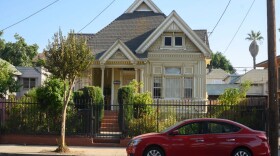We're joined on Morning Edition by KPBS Metro Reporter Alison St John, who's been working with our sister station in Los Angeles on the Station Fire. Alison, we understand you're in Pasadena now, but where have you been for the last few days?
ALISON ST JOHN: That's right, Alan, good morning. I've spent the last couple of days in the 15 mile stretch along 210 that runs along the north edge of Los Angeles west of Pasadena through Glendale, La Crescenta, La Cañada, to Tujunga. If you can imagine that northern edge of Los Angeles, it's a bit like the eastern edge of San Diego where you have those vulnerable cities of Rancho Bernardo and Poway, that's where they're right backed up against the Angeles National Forest and the very, very imposing San Gabriel Mountains. The terrain here is much steeper, of course, than it is in east San Diego County and poses a particular challenge to firefighters.
DWANE BROWN: Alison, how have residents in that area obeyed, or followed, the evacuation orders?
ST JOHN: Well, I was up in those neighborhoods where a lot of people were still at home, even though it was mandatory evacuation, watching the firefighting helicopters dropping water and fire retardant on the hills right above their homes. There was a very deliberate strategy that the firefighters were able to take here to light backfires, which are pretty scary for a lot of homeowners because it was very close to the homes, in some cases right across the road from their very upscale homes in some of those neighborhoods. But the plan was that they would burn that fire under controlled circumstances and let it burn up the hill away from the homes. So, they had a different situation from the firefighters here in San Diego where the winds are the issue. Here in 2007 they didn't have a chance in most cases to stop that fire from burning right up to homes. Here they've had days to actually plan a very deliberate strategy and backfire very gradually up the hills away from the homes in some of these areas. Then they have firetrucks lined along the street so that, if anything should happen, they can fight the fires - they can protect the homes down in the residential areas.
ST JOHN: Yes, well, there is. There are a lot of people who have not obeyed the mandatory evacuation orders - both sides of the mountain. I was at a meeting in Acton, which is on the north side in the desert, last night and a couple hundred people there who were actually pretty discontented with the amount of information they were getting. We're familiar with that. It's always hard to get up-to-date information when a fire is moving so fast. And up there it's more dangerous because it's not like you have streets, you have houses with no address, kind of tucked away down little side roads. So, I think the firefighters were finding that pretty frustrating. But the people up there were also, uh, they're very independent minded and there are a lot of ranchers, there's a lot of animals - not easy to evacuate when you have horses, sheeps, dogs and you have had no warning.
RAY: Okay, as of this morning, what details do you have about the damage estimates on the fire?
ST JOHN: It's hard to say the damage estimates. They're talking about more than 60 homes, which of course is a lot less than, I mean, we had 1600 in 2007 here in San Diego, and they haven't really said where those homes are except that only a handful are on the northern edge in the desert. So the rest must be down here. I think Tujunga Canyon was a particularly difficult area, and then there must be probably dozens more, they said, sort of backcountry cabins up in the mountains there that have been lost also.
RAY: All right, you go carefully, Alison.
ST JOHN: Thanks, Alan, see you later.
RAY: That's Alison St John, KPBS Metro Reporter.
Fire Coverage
Huge Wildfire Portends Bad Calif. Fire Season








